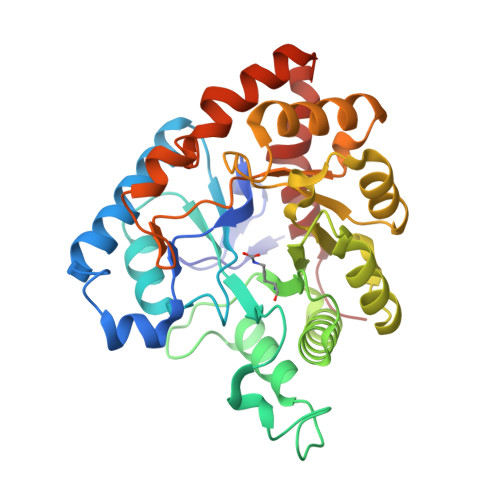The crystal structure of the phosphotriesterase from M. tuberculosis, another member of phosphotriesterase-like lactonase family.
Zhang, L., Wang, H., Liu, X., Zhou, W., Rao, Z.(2019) Biochem Biophys Res Commun 510: 224-229
- PubMed: 30704759
- DOI: https://doi.org/10.1016/j.bbrc.2019.01.069
- Primary Citation of Related Structures:
4IF2 - PubMed Abstract:
Organophosphates (OPs) have been used widely as insecticides for protecting the agricultural crops from the pests. These compounds are highly toxic because they can cause the irreversible damage to human nervous system. Phosphotriesterases (PTEs), widely exist in many different kinds of bacteria, insects and mammals, can hydrolyze phosphotriesters (one major kind of OP) sufficiently. The phosphotriesterase-activities of PTEs are considered to derive from the lactonase-activities during the evolution, and phosphotriesterase-like lactonase family (PLL), is the closest protein family to PTE family based on protein-protein blast results. But members of PLL family exhibit higher lactonase activities than the phosphotriesterase activities, while the best substrates for PTEs are phosphotriesters. In this paper, the X-ray crystal structure of phosphotriesterase from M. tuberculosis (mPHP) was solved at a resolution of 2.3 Å. The structure reveals that the mPHP is a dimer with a typical distorted (β/α) 8 barrel structure like other structures of PLL family and PTE family. The architecture of active pocket of mPHP coordinates with 2 metal ions which is also similar to other PLLs and PTEs. The activity assay proved the mPHP is biological active form and the Atomic Absorption Spectroscopy assay gave the evidence that the two metal ions bound to the active pocket were Zinc cations. The structural comparison between mPHP and other homologues concluded that the mPHP should belong to PLL family, not PTE family.
Organizational Affiliation:
College of Life Sciences, Nankai University, Tianjin, 30071, China. Electronic address: liang.zhang3@nih.gov.
















